Is Women’s American Football growing internationally?
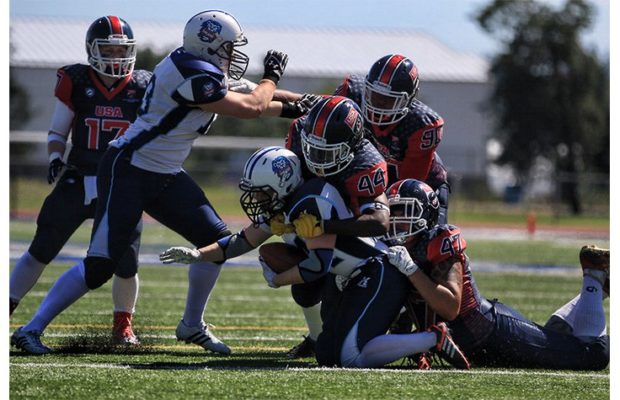
From June 24 to 30, six teams with a total of 270 women came together in Langley, BC in Canada for the IFAF Women’s World Championship. They were all seeking to be crowned the world’s top women’s football team. The United States, as expected, won the tournament, downing Canada in the final.
In fact, of the six teams, only the United States and Canada, had a realistic shot of being in the final game. Two more – Finland and Britain, had considerable international experience. The Finns had finished third in the two previous Women’s World Championship, and the British had finished second to them in the 2015 IFAF European Championship. The final two – Australia and Mexico were unknown quantities, playing in their first international championship. Australia had garnered considerable publicity by securing Dr. Jenn Welter, the first woman to coach with an NFL team, as their head coach, but Mexico was a total cipher.
United States has numbers/rules advantage
The USA has had the longest experience with women playing football, with the first semi-professional teams beginning play in the 1970s, and currently has six leagues totaling more than one hundred teams.
The players from Team USA came mostly from the Women’s Football Alliance, which supplied 42 of the players for the American team, with the rest coming from the Independent Women’s Football League. Those two leagues also supplied several players for the Canadian team (from the Montreal Blitz of the WFA), as well as players for Australia and Mexico.
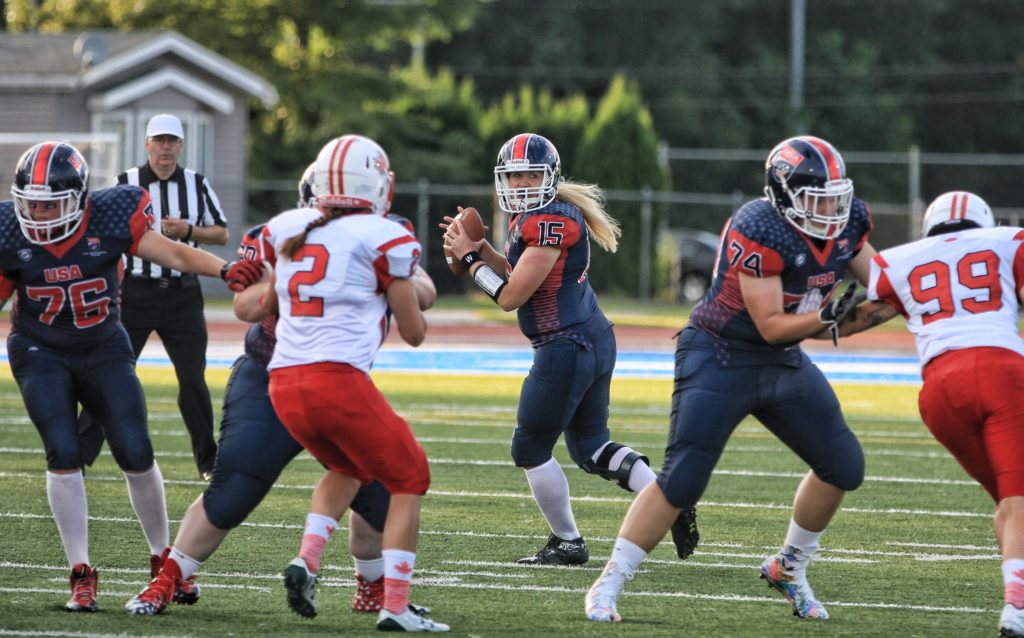
Team USA vs Canada Photo: David Zuskind
The USA also had home rules advantage. The games were played with 11-women-a-side, using NCAA rules. Many Canadian teams play under CFL rules, with 12-women-a-side, a larger field, and pre-snap motion allowed. The regular season for the 19 British teams is played by 7-a-side teams, with the final Diamond Series contested by 11-a-side teams drafted from the regular teams. Depending on where a woman plays in Australia, they might play with 7 or 9 players, and they have only nine teams that have been playing for just five years. DL Jasmin Collins, who was the Player of the Game for the team’s last game against Finland, played her first football game against Canada on day 1 of the championship. The Mexicans have only recently begun play for women, but many of the women play in arenas with 8 women teams. The Finnish women started playing football in 2008, and have transitioned from 7 or 9 players to 11-a-side to play more effectively internationally.
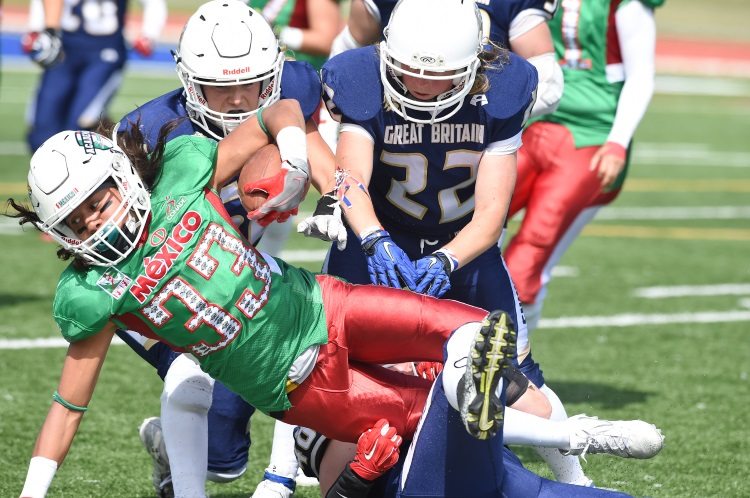
Team Mexico vs Great Britain Photo: David Zuskind
With their advantages of experience, and familiarity with the format, the USA rolled to the championship, defeating the Mexicans 29-0, the Finns 48-0, and the Canadians 41-16. The Canadians surged to the championship game overcoming the Australians 31-6, and the British 35-0. Their matchup in the final demonstrated that though the USA has large advantages, the differences between teams might be declining (the USA margin of victory over Finland also shrank from 72-0 in 2010 to 48-0 this year).
In two previous meetings in the WWC final, the Canadians were routed 66-0 in 2010, and 64-0 in 2013. The 25 point victory margin in the final was the closest any team had yet come to the champions. Britain also turned the tables by defeating the Finns in the first game of the championship. They turned around a 50-12 defeat in the 2015 European Championship to a 27-21 victory, although the Finns failed to capitalize on a drive to the British 5 yard line as time ran out. Even though they had a number of talented and aggressive athletes, the Australian’s inexperience showed, and even the innovative offensive formations imported from the U.S. could not help them find the victory column. The Mexicans were the surprise of the tournament. After losing to the USA, they defeated Australia 31-10, and Britain 19-8. Their speed and swarming tackling helped them overcome their experience deficit against the British, who were bigger, stronger, and more experienced.
North American dominance
Although the talent margin may be drawing closer from previous years as other nations gain experience, the gap is still wide. The North Americans – USA, Canada, and Mexico took the top three spots, and in the championship game, the speed and ferocity of play was noticeably elevated.
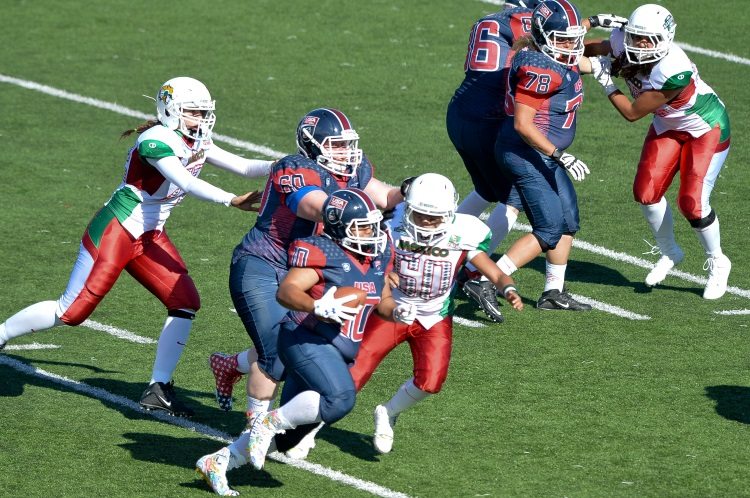
Team USA vs Mexico Photo: David Zuskind
It was likely that the top finishers might have scored more in the first two games, but as USA coach Jim Farrell mentioned in a post-game conference, his team was “not trying to do anything bad to our opponents. We’re just trying to the best ambassadors of this game as we possibly can.”
Rest of world catching up
Still, as more women gain experience playing the game, the differences may continue to dwindle. There are also an increasing number of American women who are traveling abroad to play, and women from other countries coming here to play. During the tournament I talked with OL Sybil Gonzales of the Mexican team who had spent the past season playing for the Carson Bobcats of the IWFL, hoping to gain more experience.
Finland’s OL Suvi Mantyniemi also told me that she had played in Finland with Lea Kaszas, who also plays with the Indy Crash of the WFA. This sort of cross pollination might also help even out some of the competitive differences among teams.
IFAF rift a concern
A concern might be that some women’s teams from Europe might not join in international competitions such as these due to the schism between IFAF New York and IFAF Paris, which will hinder that process, although the Women’s World Games, that have been held in New Orleans in 2016, and Orlando in 2017, is a useful workaround. The games bring together women from various nations to sharpen their games. Most of these factors point to women’s football improving. Whether there will be enough improvement to unseat the Americans or Canadians from their top spots in time for the next Women’s World Championships, though, remains to be seen.
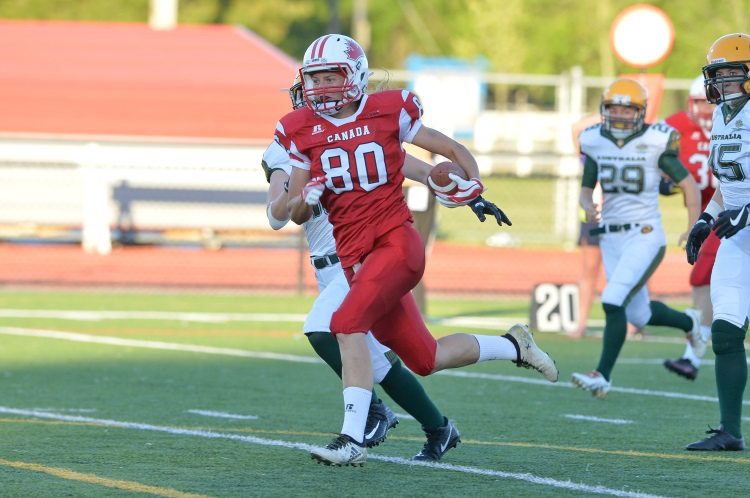
Team Canada vs Australia Photo: David Zuskind
Women’s tackle football definitely growing
The football season is not yet through for many of the women who played at McLeod Stadium. Many will return to join their regular teams that are still in their regular seasons, or in the playoffs. The nine WFA players drawn from the Montreal Blitz, for instance, will be playing against the Tampa Bay Inferno next weekend, and players from other WFA teams will also have playoff games leading up to championship weekend in Pittsburgh on July 21-22. The same is true for the Mexicans. The Finns and British, in addition to their regular seasons, will be aiming for the 2019 European Championship. Some Mexican players mentioned that they have teams that are still in the hunt as well.
Women’s tackle football is growing – more and more women are playing a sport that some parents consider too dangerous for their sons, and seemingly the level of play is tightening around the world. Kicker Becca Longo recently became the first female athlete to be offered a scholarship to play Division II football at Adams State, and Sam Gordon, a youth player from Utah, has recently brought suit against local school districts to force them to create tackle football teams for girls. Perhaps as more women play, press sources other than American Football International will begin paying attention to women’s football.